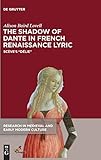The Shadow of Dante in French Renaissance Lyric : Scève’s “Délie” / Alison Baird Lovell.
Material type: TextSeries: Research in Medieval and Early Modern Culture ; 26Publisher: Kalamazoo, MI : Medieval Institute Publications, [2020]Copyright date: ©2021Description: 1 online resource (X, 273 p.)Content type:
TextSeries: Research in Medieval and Early Modern Culture ; 26Publisher: Kalamazoo, MI : Medieval Institute Publications, [2020]Copyright date: ©2021Description: 1 online resource (X, 273 p.)Content type: - 9781501517976
- 9781501513466
- 9781501513596
- 841.3 23/ger/20230216
- online - DeGruyter
- Issued also in print.
| Item type | Current library | Call number | URL | Status | Notes | Barcode | |
|---|---|---|---|---|---|---|---|
 eBook
eBook
|
Biblioteca "Angelicum" Pont. Univ. S.Tommaso d'Aquino Nuvola online | online - DeGruyter (Browse shelf(Opens below)) | Online access | Not for loan (Accesso limitato) | Accesso per gli utenti autorizzati / Access for authorized users | (dgr)9781501513596 |
Browsing Biblioteca "Angelicum" Pont. Univ. S.Tommaso d'Aquino shelves, Shelving location: Nuvola online Close shelf browser (Hides shelf browser)

|

|

|

|

|

|

|
||
| online - DeGruyter Space, Image, and Reform in Early Modern Art : The Influence of Marcia Hall / | online - DeGruyter Polemic and Literature Surrounding the French Wars of Religion / | online - DeGruyter Current Trends in Nigerian Pidgin English : A Sociolinguistic Perspective / | online - DeGruyter The Shadow of Dante in French Renaissance Lyric : Scève’s “Délie” / | online - DeGruyter Mapping Ideology in Discourse Studies / | online - DeGruyter Experimental Insights into the Syntax of Romanian Ditransitives / | online - DeGruyter Poetic Style and Innovation in Old English, Old Norse, and Old Saxon / |
Frontmatter -- Acknowledgments -- Contents -- List of illustrations -- Textual Note -- Introduction -- 1. “Ce Poëte ayant quasi l’esprit et l’entendement de Dante” -- 2. Scève and fin’amor: “Jouir d’un coeur, qui est tout tien amy” -- 3. Scève, Ficino, Cavalcanti: “Parfeit un corps en sa parfection” -- 4. Scève and Dante: “Fedeli d’amore” -- 5. Scève and Dante: “Incessamment travaillant en moy celle” -- 6. Scève and Dante: “L’amor che qui raffina” -- 7. Scève and Petrarch: “Ardor fallace” -- 8. Scève and Petrarch: “Constituée idole de ma vie” -- Conclusion -- Selected Bibliography -- Index -- Index of Poems and Cantos Cited
restricted access online access with authorization star
http://purl.org/coar/access_right/c_16ec
This book presents an interpretation of Maurice Scève’s lyric sequence Délie, object de plus haulte vertu (Lyon, 1544) in literary relation to the Vita nuova, Commedia, and other works of Dante Alighieri. Dante’s subtle influence on Scève is elucidated in depth for the first time, augmenting the allusions in Délie to the Canzoniere of Petrarch (Francesco Petrarca). Scève’s sequence of dense, epigrammatic dizains is considered to be an early example, prior to the Pléiade poets, of French Renaissance imitation of Petrarch’s vernacular poetry, in a time when imitatio was an established literary practice, signifying the poet’s participation in a tradition. While the Canzoniere is an important source for Scève’s Délie, both works are part of a poetic lineage that includes Occitan troubadours, Guinizzelli, Cavalcanti, and Dante. The book situates Dante as a relevant predecessor and source for Scève, and examines anew the Petrarchan label for Délie. Compelling poetic affinities emerge between Dante and Scève that do not correlate with Petrarch.
Issued also in print.
Mode of access: Internet via World Wide Web.
In English.
Description based on online resource; title from PDF title page (publisher's Web site, viewed 25. Jun 2024)


